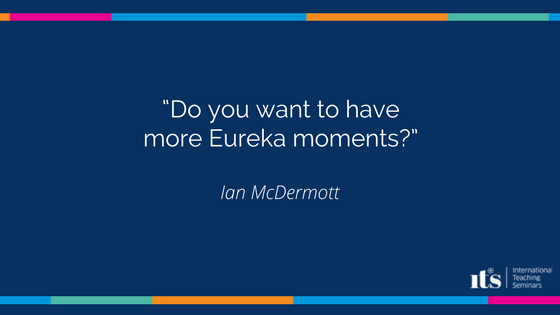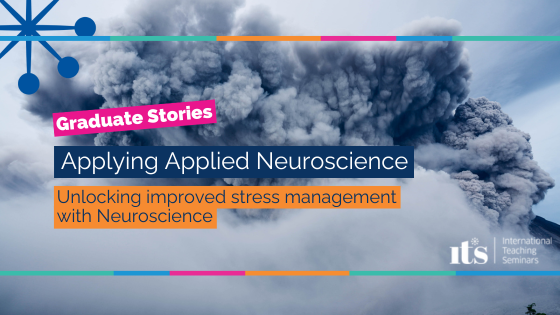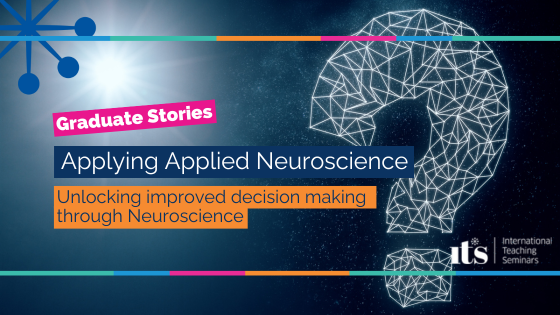Ian McDermott and Patricia Riddell, Professor of Applied Neuroscience on how to use your brain more effectively.
While some new insights evolve out of careful and considered planning, many arrive suddenly from a pure, new inspiration – a Eureka moment! Instantly, you know that the solution will work, and you can start to plan your new approach.
If you know what is happening in your brain when you produce such inspirational new thoughts, you might just be able to put yourself and your colleagues in the right place and the right state for new insights to happen more often.
Insights occur when people put together ideas that are only loosely associated in their heads. This is hard work most of the time since our brains are designed to put together the ideas that are most strongly associated. You can see how this works in everyday life. For instance, if we ask you to think of a bird, you are more likely to think of a robin or a blackbird (common types of bird) than a penguin or an emu (which are unusual birds).
In order to have insight, we have to inhibit strong associations so that the weaker and new associations can come to our attention. Put another way, insight happens not when we are focussed intently on a solution (and so activating common answers), but when we are allowing our focus of attention to drift beyond the problem at hand (when our brain has access to more options). It is when we are not earnestly thinking about the solution that insight or AHA moments occur.
Recently, scientists have shown that people who are in positive moods solve more problems – and are more likely to solve these problems using insight – than people who are less positive or even anxious. Scientists are now beginning to work out why positive moods are conducive to producing insights.
Participants are asked to solve problems where they are given three words (e.g. tooth, potato and heart) and asked to think of a single word that can be used in conjunction with each of the three words.
If the participant solves this problem, they are then asked whether they had to work at a solution by trial and error (cognitive problem solving) or whether they came up with the answer suddenly and just knew it was right (insightful problem solving).
What researchers have found is that an area of the brain – the dorsal anterior cingulate cortex – is more highly activated both when we are in a positive mood, AND just before we solve problems using insightful but not trial and error processes.
Why is this part of the brain so important? One function of this area is to inhibit our strong, learnt, habitual responses to typical situations, allowing those more indirect responses to come into awareness – exactly what we need to be more insightful.
Another thing this brain area does is to take note of our emotional response to events – exhibiting higher activity when we are happy. These two separate functions just happen to be controlled by the same area of the brain.
So, positive mood does not directly cause you to be insightful. Instead, anything that activates the area of your brain which inhibits your habitual responses helps you to be more insightful – and this includes being happy!
This blog is based on the following article:
Jung-Beeman, M. Bowden, E., Haberman, J., Frymiare, J., Arambel-Liu, S., Greenblatt, R., Reber, P & Kounios, J. (2004) Neural activity when people solve verbal problems with insight. PLoS Biology, 2, 0500-0510.
What you can do:
If you want to learn how to use your brain more effectively, put neuroscience to work:
- Think of some situations in which insightful solutions would help you move forward and use these to practice.
- Learn what enables you to change your state at will so that you can choose to be happy and avoid excessively narrow focusing. This might involve upbeat music, sharing jokes with friends, going for a short walk or a run, spending time with family etc.
- When you are looking for solutions or choosing options, be open to the most bizarre suggestions in the first instance. Narrowing down to the best option can come later.
- Change your location – do your thinking in a different context. This can allow you to think of solutions that fit for a particular context but that you would never have previously considered using.
- Notice when your thinking is narrow or when you resort to the most obvious solutions. Is it when you are stressed, working to a tight deadline, caught up in worries or what? As you begin to notice what results in narrow thinking, plan to change the triggers.
- Remember the same applies to people in your team. Consider, are you creating the optimal conditions to maximize their performance?
- If in doubt consider learning to meditate as good research indicates it is effective in giving you the mental space to generate more innovative ideas.
Ian McDermott and Professor of Applied Neuroscience, Patricia Riddell, began working together so that credible neuroscience with practical pay-offs could be made available. Our experience combines Patricia’s in neuroscience and psychology with Ian’s in delivering real behavioural change for individuals and organisations. As consultants we advise on how to apply current research so individuals, teams and organizations can be more effective. For us the question is always, whatever your approach, is it neuroeffective?
For public training check out our Certificate in Applied Neuroscience
For in-house applications to improve individual, team and organisational performance contact the Neuroeffective Team at info@itsnlp.com





Leave A Comment